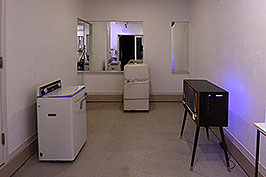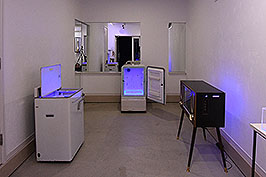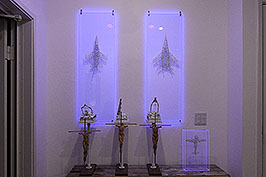Le visible et l'invisible 見えるものと見えざるもの-三種の神器のナラティヴ-
 |
 |
 |
 |
 |
 |
 |
 |
Le visible et l'invisible
The visible and the invisible – narratives of the three Imperial treasures –
Gallery YORI 2023 10.29 - 11.11
"La visible et l'invisible" (The visible and the invisible - narratives of the three Imperial treasures) is based on the overall exhibition concept of "Seeing, The difference between watching and looking.
It examines the overall structure of the work, which is meant to "question what kind of action is the perception of existence".
According to the philosopher Maurice Merleau-Ponty in his last writing "La visible et l'invisible suivi de notes de travail" note 1:
"The world of 'what is', the world of material things, is the world of 'what is'. I am not yet a pure observer when I ask what is the material thing. I become an observer by an ask of ideation." Note 2.
This means that only those who can 'recognise' that the depicted smoking pipe is a 'smoking pipe' can understand the existence of the 'smoking pipe'.
However, this means that those who do not know the 'smoking pipe' beforehand will not be able to understand what is depicted in the 'picture'.
The subtitle 'Narrative of the Three Imperial Ttreasures ' refers to the fact that no one has actually seen the three sacred treasures derived from Amaterasu in the Kojiki and Nihonshoki.
Even today, proof of the existence of 'the Three Imperial Ttreasures ' continues to be an absolute requirement for the generational change of the rulers of the land.
However, it has been customary for more than two thousand years that the reality of the Three Imperial Ttreasures is kept in a strict box and never disclosed to the people.
In contrast, the new King Charles III, who recently succeeded to the throne, made it an absolute condition that the 'crown' and 'scepter', the proof of existence of the ruler,
be disclosed directly to the people. What percentage of the British public is aware of how the three sacred objects are handled in Japan?
To see or not to see, to watch or not to watch, to look or not to look?"
The exhibition questions our perception as observers from within the melting pot of conventional wisdomnote3 of these huge 'Son-Taku(reading what someone is implying)'.
Note 1, edited and published by Claude Lefort, who studied under him after his death.
Note 2, edited and translated by Nakamura Hajime, Merleau-Ponty Collection, Chikuma Gakugei Bunko.
Note 3, Socially accepted ideas are matters that are tacitly understood in human society, even if they are not explicitly stated, as in the case of laws. Common sense ideas and common sense among the public.
Le visible et l’invisible
見えるものと見えざるもの −三種の神器のナラティヴ−
Gallery YORI 2023 10.29 – 11.11
“La visible et l’invisible 見えるものと見えざるもの −三種の神器のナラティヴ−”は、展示全体のコンセプトに通底する「見る、観る、視る、ことの違い。存在の認識とはいかなる行為かを問う」という意味を込めた作品全体の構成を考察している。
哲学者モーリス・メルロ=ポンティ(Maurice Merleau-Ponty)の絶筆となった “La visible et l’invisible suivi de notes de travail"注1
によると「<何かあるもの>世界、物質的な事物とは何かを問う際には、わたしはまだ純粋な観察者ではない。イデア化の行為によって観察者になるのである。」注2とある。
これは、描かれた喫煙パイプが「喫煙パイプ」であることを「認識」することができる者のみが「喫煙パイプ」の実存を理解できるのである。しかし、事前に「喫煙パイプ」を識らない者には何を描いたのか理解できない「絵」になってしまうことを意味している。
サブタイトルにある「三種の神器のナラティヴ」は、古事記、日本書紀にある天照大神由来の三種の神器を、二千年以上も実物を観た者がいない事に通ずる。
現代においても、この土地の統治者の世代交代には「三種の神器」の存在証明が絶対条件であり続けている。しかし、その実態は、厳かな箱の中に収めてあることにして、民衆には絶対に開示しないことが1000年以上の慣例となっている。
翻して、先日王位を継承したチャールズ3世新王は、統治者であることの存在証明である「王冠」や「杖」を民衆に直接開示することが絶対条件であった。はたしてイギリスの民衆の何%が日本における三種の神器の取り扱い状況を識っているのだろうか?
「在るモノを、見るのか見ないのか、観るのか観ないのか、見えないのか視えないのか、みない、みたくない、みえないようにする、在るか無いか、わからない、きおくにございません」これらの巨大な忖度という社会通念注3のるつぼの内側から我々全体が観察者として知覚することを問う展示となっている。
注1、没後、師事していたクロード・ルフォールにより編集刊行
注2、編訳、中村元 メルロ=ポンティコレクション、ちくま学芸文庫
注3、社会通念とは、法律のように明文化されていなくても、人間社会において暗黙の了解となっている事項のこと。常識的な考え方や世間一般の常識など。